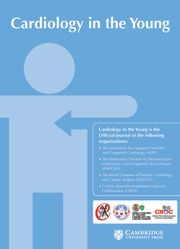No CrossRef data available.
Article contents
Unexpected and atypical clinical presentation of myocardial infarction in infants and children: complex pathogenesis of progressive and lethal disease
Published online by Cambridge University Press: 08 October 2024
Abstract
Myocardial infarction is rare in children but frequently occurs unexpectedly with atypical presentation. It can cause a progressive lethal course unless prompt treatment is initiated.
Paediatric cases of myocardial infarction diagnosed by the presence of ischaemic myocardial insults and symptomatic ventricular dysfunction were reviewed retrospectively.
Eighteen patients (5 days to 14 years of age; median 3 months) with myocardial infarction were studied. The aetiology was variable, including congenital coronary anomalies: anomalous left coronary artery from pulmonary artery (five patients), pulmonary atresia with intact ventricular septum with right ventricle-dependent coronary circulation (four), anomalous aortic origin of left coronary artery (three), and Williams syndrome with supravalvar aortic stenosis (one). Two acquired coronary anomalies occurred in one patient with undiagnosed Kawasaki disease with complete thrombotic obstruction of the left coronary artery and another with post-transplant cardiac allograft microangiopathy. Three patients developed thromboembolic coronary artery incidents in normal coronary anatomy. Fourteen patients were less than 1 year of age (78%). Electrocardiographic abnormalities were noted in all patients. Four patients required extracorporeal membrane oxygenation support for severe ventricular dysfunction, none of whom survived. Five patients underwent heart transplant. Five patients died during the same hospitalisation, and one patient died after discharge (overall mortality 33%). Transplant-free survival was 39%.
Most myocardial infarction occurred in infants who presented with abrupt onset of non-specific clinical manifestations with progressively deteriorating haemodynamic status resulting in poor transplant-free survival rate. Early diagnosis and treatment are essential to prevent catastrophic outcomes.
- Type
- Original Article
- Information
- Copyright
- © The Author(s), 2024. Published by Cambridge University Press



